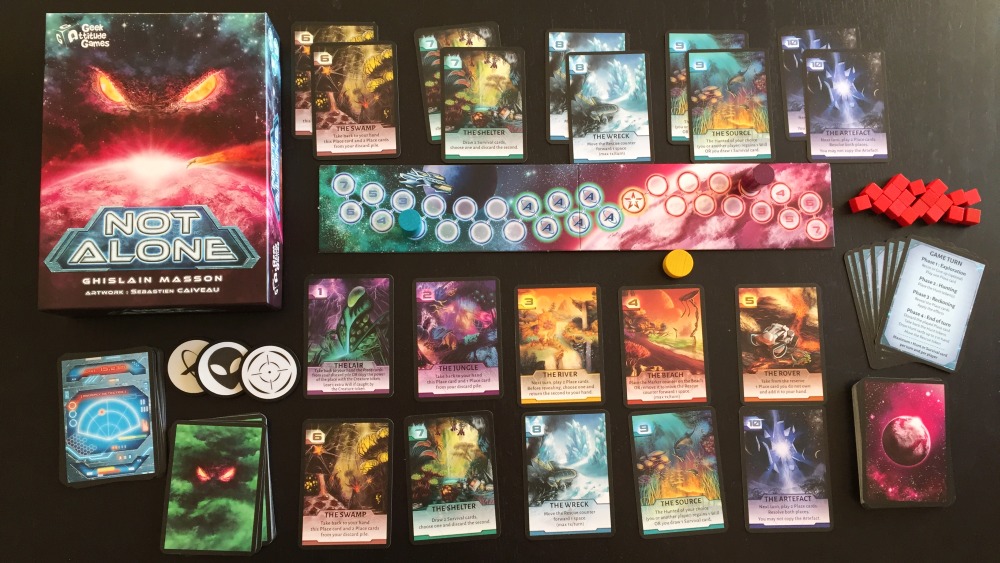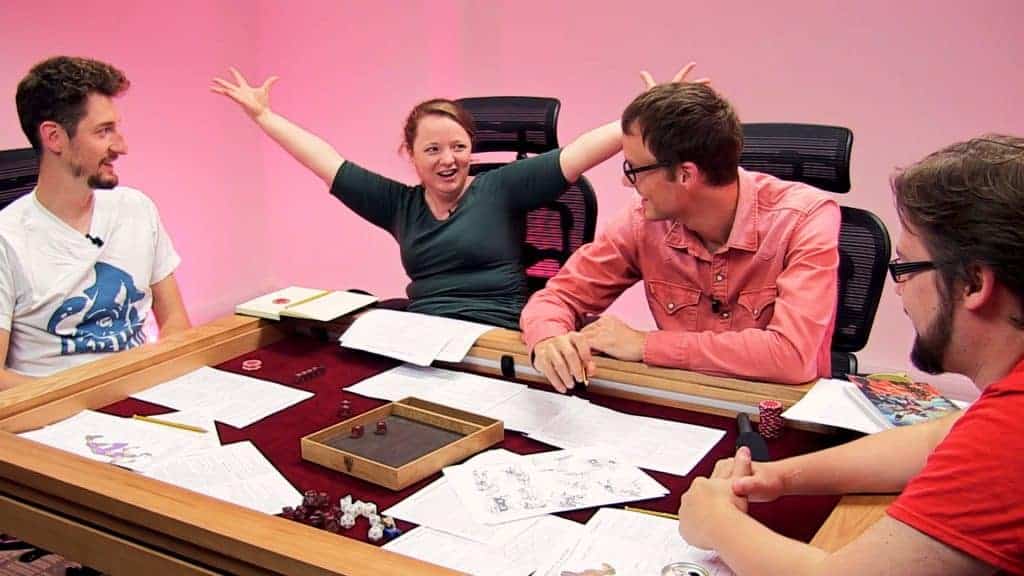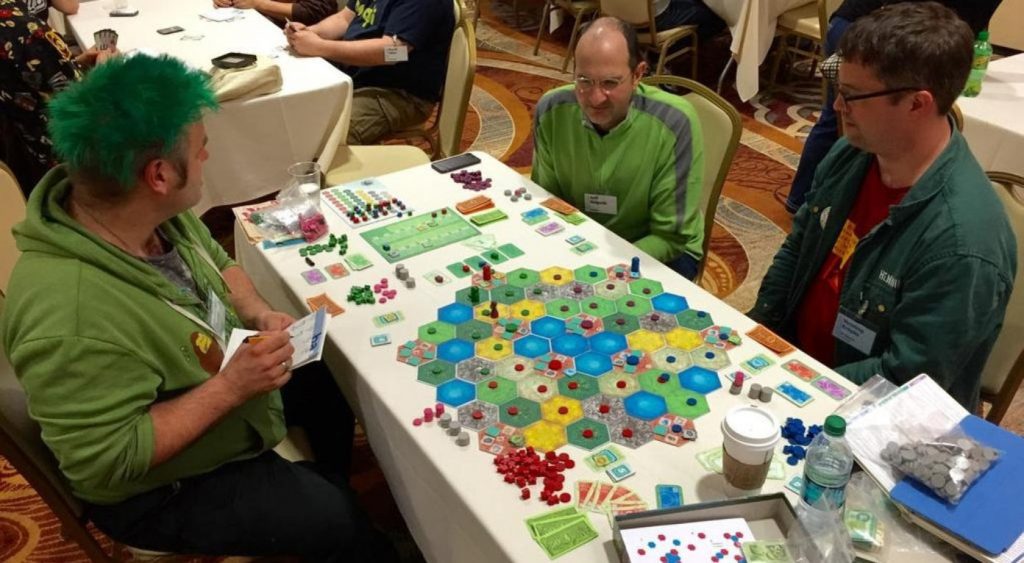Quinns: You and I need to talk about Not Alone. There are more exciting card games out there, and funnier ones, and ones that are sharp as a tack, but Not Alone is the most deliciously playable little game we’ve encountered since Crossing. This box might as well be full of popcorn.
Between 1 and 6 players are the survivors of a crash-landing on a wild alien world. This team (possibly made up of just one nervy player) is opposed by one final player controlling the beast that lives there. A long, thin board measures the progress of each team: The humans win if they can survive until help arrives, the beast wins if it can wear down the humans and absorb them into the ecosystem like beer into a shag carpet.
Each turn, each human player plays a card face-down showing where they’re going, and the beast has to second-guess their movements and slap fat poker chips onto those locations, invalidating your turn or worse. If the beast itself catches you then it devours a precious “Will” cube.
Do I have your interest? Of course I do. You’re a weak-willed human, and this game is a seductive new land. Let’s go exploring.

Not Alone really is as simple as I made it sound. Here’s a runthrough of a turn:
Step 1. The human players all play a card from their hand face-down onto the table while giggling nervously or talking an incredible amount of nonsense, e.g. players all agree to “Meet at the lair,” or “Have a sexy party on the beach.”
Step 2. Doing their best to ignore this comedy gaslighting the alien player places their “hunt” chip on a location, and also plays a card from its hand that might give it yet more chips to place. Where do they think the humans went? Is it the right time to play this card… ?
Step 3. The humans reveal where they went. Anyone who went somewhere free of chips gains that location’s reward and an unbearably smug demeanour. Humans that went somewhere with a chip get nothing, and they might lose will tokens or cards from their hand depending on the chip.
If all of the humans avoided the alien, or the alien caught all the humans, that team now enjoys a brief but very real sense that this is the greatest game ever made.
Step 4. The alien collects its chips, draws a new card, the humans advance their escape tracker. Repeat until someone has second-guessed their way to victory.

The strategy in Not Alone quite literally comes from a few different places. Humans all start with a hand of 5 cards depicting locations 1-5, but you’ll notice that at no point in the above order of play do the humans pick up the cards they’ve played, so their choice of locations narrows each turn.
Successfully hiding in the Jungle for a turn (location 2) lets you pick your Jungle card back up as well as one other card in your discard pile. Alternatively, you could visit the vitally important planetary Rover (location 5) which lets you figure out a route to the rest of the planet (locations 6 though 10) and add one of those cards to your hand. Included in these is the swamp (location 6) which is basically an upgraded Jungle action and lets you pick three cards back up.
Ensuring you don’t run out of cards is important for a couple of reasons. Discard piles are visible, so the alien might only have a 20% chance of catching a player initially, but if you only have one card in your hand then that can rise to 100%. Except if the human team THINKS that the alien will pounce on the player who only has one card left, the alien could then surprise them by instead visiting the Rover. The human team thought this was the one turn they could get away with it! They were wrong.

If a human completely runs out of cards they have to discard all of their Will cubes in order to pick their hand back up, and any time they run out of Will (either from running out of cards or being stalked continually) they also have to advance the alien tracker towards the “Alien wins!” space.
All of which is interesting, but it’s even more evocative. At the start of a game you have this claustrophobic fumbling back and forth across the first 5 cards, but as more players manage to slip into the Rover and add cards to their hand the alien has to cover more territory. Players also start deviating into different roles- someone manages to get into the Rover twice and start recovering valuable survival equipment. Someone else spends almost the whole game hiding in the swamp. Another player is down to one Will cube and to hell with the rest of the game, he just wants to avoid the beast.
At its best – and this game is fighting fit and routinely at its best – Not Alone feels a like a magic trick, captivating an entire table with just a few cards and some misdirection.

That this game tells such a fun story is all the more impressive considering Not Alone only really has ten proper card illustrations, one for each of the game’s locations. But each one is an illustration you could gaze at for minutes on end, and the powers are always so fun.
Visiting the alien’s Lair (location 1) lets you copy the power of wherever the alien is – so, probably the one place it desperately doesn’t want you to go – but that’s a brave play because if the alien catches you at its lair you lose double the Will cubes. The Beach (location 4) and the Wreck (location 8) let humans nudge forward the tracker that determines when help arrives (I imagine them standing at the beach and just pinwheeling their arms at the sky), so successfully visiting either one feels tremendously heroic, but being caught there is miserable.
“What were you thinking?” a good alien player will ask you. “Nobody’s coming for you. Just settle down here with me.”

It’s not just that the game and theme are perfectly matched in Not Alone. That alone wouldn’t be enough for me to recommend it. It’s that game and theme both fit together so well and both of them feel fresh. It would have been so easy to illustrate Not Alone with a grimdark planet packing a predictable predator, but instead we get this empurpled world with marmalade skies and an alien that just wants you to stay here.
On the same note, yes, the game you’re playing is excellently tense. Every turn you make an interesting decision with impactful consequences, pushing you towards an awesome endgame where every card and every chip could spell the end of the game. But that alone wouldn’t be enough. What leads me to recommend Not Alone is that it’s also such a peculiar social dynamic. The human team is working as one, but since discussions take place in front of the alien your interactions with your team are almost exclusively limited to (a) camaraderie and (b) talking absolute bollocks to annoy the alien, which has the bizarre side effect of making the alien seem like the good guy as these idiot humans go stomping around the planet like Americans in Tijuana.
Playing as that alien is even weirder! There are any number of games where you need to get in someone’s head. This is the first I’ve played where you’re expected to loosely predict a whole team by yourself.

It’s simple, it’s thematic, it’s fun, and it can host 2 players as easily as it can host 7. Shut Up & Sit Down recommends Not Alone. The only flaw to consider before buying it is that some of the rules on the cards can be just a little unclear, and your first game is going to require a bit of democracy from your group as to precisely how they work. I know that drives some people up the wall. It didn’t get in the way of our enjoyment, though. Nothing did! What a box.
Though if I’m completely honest, every time I play this game I can’t help but fantasise about it being a big box game. I’d love to see these mechanics transposed onto a big, beautiful board, but with humans also trying to manage scarce resources, and perhaps some secret communication allowed, and systems for building shelters and hides, and… oh my, you could do so much with this idea. It could be a bit like Star Wars Rebellion, except instead of manufacturing Y-Wings in your secret base you’re sequestering sandwiches in a bog.
Or lots of complex systems ruin it? Would it be best to simply be content with what we have? Perhaps I should stop resisting and just settle here.
Perhaps…




